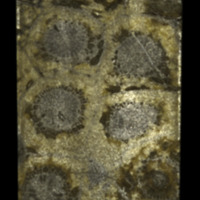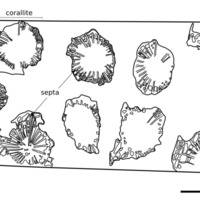- Home
- Rocks
- Type fossils
- Fossil Specimens
- Minerals
- Glossary
- Stratigraphic Chart
- Michel-Levy Chart
- Classification of igneous rocks
- University of Cambridge
- Department of Earth Sciences
- ESC Library
- Moodle
- Sedgwick Museum
- DoITPoMS
- Mindat.org
- Microfossils
- Bryozoans
- Webmineral
- Tree of Life
- CrystalMaker
- Virtual Microscope
TF1103 - Rugose Coral
Stratigraphic Range
Ordovician to Permian
Taxonomy
Phylum: Cnidaria
Class: Anthozoa
Order: Tabulata
Class: Anthozoa
Order: Tabulata
Distinctive Features
Septa
Colonial
Columella
Polyps
Colonial
Columella
Polyps
Preservation
Mineral replacement of skeleton
Precipitation of minerals in spaces
Precipitation of minerals in spaces
Advanced notes
The presence of columella (central support structures) and septa allow identification of this fossil as a colonial rugose specimen. Columella are not present in tabulate corals as these are always colonial, and do not need the extra support.
Solitary rugose corals developed columella as an internal support structure, and it was retained for some colonial forms, such as this one.
Solitary rugose corals developed columella as an internal support structure, and it was retained for some colonial forms, such as this one.


